Gingerbread palm, Doum palm
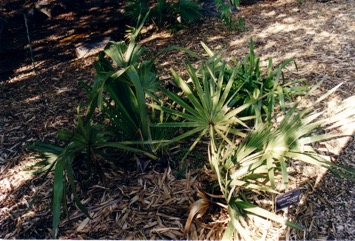
A tropical plant. It will grow in warm temperate, subtropical and tropical regions. It will not tolerate frost. It grows in coastal regions. It can grow in arid places. It is found in the drier parts of West Africa. It grows in the Sahel. It is often on soil left by floods from rivers. It forms dense stands in hot dry valleys. They grow where the temperature is 20°C to 35° or 40°C. They grow up to 600 m altitude. They are common in areas with a rainfall between 150 and 600 mm per year. They can grow on saline soils. It can grow in arid places. They prefer a soil pH of 6.5-7.6. They are pollinated by wind. It suits hardiness zones 10-12. In Townsville palmetum.
Also known as:
African Doum palm, Baar, Babazla, Bar, Bri-goruba, Dom, Doum, Dum palm, Gara'ito, Gellohi, Goriba, Goruba, Karjim, Kunchula, Manie, Meti, Mukpiatikakadata, Na, Poro, Qoone, Sete, Unga
Synonyms
- Chamaeriphes crinita (Gaertn.) Kuntze
- Chamaeriphes thebaica (L.) Kuntze
- Corypha thebaica L.
- Cucifera thebaica (L.) Delile
- Douma thebaica (L.) Poir.
- Hyphaene baikieana Furtado
- Hyphaene crinita Gaertn.
- Hyphaene dahomeensis Becc.
- Hyphaene dankaliensis Becc.
- Hyphaene guineensis Schum. & Thonn.
- Hyphaene nodularia Becc.
- Hyphaene occidentalis Becc.
- Hyphaene santoana Furtado
- Hyphaene sinaitica Furtado
- Hyphaene togoensis Dammer ex Becc.
- Hyphaene tuleyana Furtado
- Palma thebaica (L.) Jacq.
Edible Portion
- Cabbage, Fruit starch, Kernel, Leaves, Palm heart, Nuts, Root
Where does Gingerbread palm grow?
Found in: Africa, Asia, Australia, Benin, Burkina Faso, Cameroon, Central Africa, Central African Republic, CAR, Chad, China, Congo, Congo DR, Côte d'Ivoire, Djibouti, East Africa, Egypt, Eritrea, Ethiopia, Gabon, Gambia, Ghana, Guinea, Guinée, Guinea-Bissau, India, Indonesia, Iran, Israel, Ivory Coast, Kenya, Liberia, Libya, Madagascar, Mali, Mauritania, Mozambique, Niger, Nigeria, North Africa, North America, Pakistan, Palestine, Sahel, Saudi Arabia, SE Asia, Senegal, Sierra Leone, Somalia, South Africa, Southern Africa, South Sudan, Sri Lanka, Sudan, Tanzania, Togo, United States, West Africa, Yemen, Zambia, Zimbabwe
Notes: There are about 9 or 10 Hyphaene species. (Some authorities estimate 40). Chemical composition (per 100g )(leaves): Protein = 2.3g. Fat = 0.4g. Calcium = 210 mg. Kcal = 43; (nut, dried): Protein = 3.9g. Fat = 6.4g. Calcium = 144 mg. Kcal = 395; (flour): Protein = 2.6g. Fat = .4g. Calcium = 68 mg. Iron = 20 mg. Vitamin B1 = .05 mg. Vitamin B2 = .10 mg. Niacin = 3.4 mg. Kcal = 296; (nut, green: outer, edible portion): Protein = 1.4%. Fat - 0.1%. Carbohydrate = 13.6%. Fibre (crude) = 5.4%. Ash = 1.5%. CaO = 0.05%. P2O5 = 0.13%. Moisture = 78.0%. Kcal = 62; (nut, green: kernels and fluid): Protein = 1.9%. Fat = 0.2%. Carbohydrate = 19.8%. Fibre (crude) = 1.4%. Ash = 0.7%. CaO = 0.07%. P2O5 = 0.03%. Moisture = 76.0%. Kcal = 91; (nut, mature; edible portion): Protein = 2.8%. Fat = 0.4%. Carbohydrate = 74.7%. Fibre (crude) = 11.0%. Ash = 5.4%. CaO = 0.17%. P205 = 0.39%. Moisture = 5.7%. Kcal - 321. Chemical composition, after Abdelmuti) Protein (crude) = 1.7% (dry). Fat = 0.5% (dry). Ash (insoluble) = 1.9% (dry). Fibre (crude) = 7.3% (dry). Amino acids (g [16g N]-1): Aspartic acid = 6.8g. Threonine = 2.7g. Serine = 3.7g. Glutamic acid = 9.0g. Proline = 3.8g. Glycine = 5.3g. Alanine = 4.0g. Valine = 4.0g. Cysteine = 1.2g. Methionine = 1.5g. Isoleucine = 4.0g. Leucine = 5.3g. Tyrosine = 2.2g. Phenylalanine = 3.7g. Lysine = 2.8g. Histidine = 1.5g. Arginine = 4.3g. Minerals: Sulphur = 0.30% (dry). Potassium = 0.14% (dry). Magnesium = 0.28% (dry). Calcium = 0.13% (dry). Na = 0.09% (dry). K = 3.02% (dry). Zinc = 11 mg/kg (dry). Iron = 17 mg/kg (dry). Manganese = 11 mg/kg (dry). Copper = 25 mg/kg (dry).
Growing Gingerbread palm, Doum palm
Cultivation: Plants are grown from seed. Sometimes suckers are used. Seed should either be sown in a deep container or direct in the field. The seeds take a long time to germinate.
Edible Uses: The spongy middle layer of the fruit is used for flour. The kernel is eaten. The seed kernels are sprouted in soil then eaten. The young fruit are boiled and eaten. The palm cabbage is edible. The shoot from the developing seed before leaves emerge can be eaten. The sap from the growing point can be drunk fresh or made into wine. The trunk contains a kind of sago starch which is edible.
Production: The first harvest occurs after 6-8 years. Fruit ripen in 8-12 months. A tree lasts for about 60 years. Tapping the tree for sap kills the palm.
Nutrition Info
per 100g edible portion| Edible Part | Energy (kcal) | Protein (g) | Iron (mg) | Vitamin A (ug) | Vitamin c (mg) | Zinc (mg) | % Water |
|---|---|---|---|---|---|---|---|
| Nuts dried | 395 | 3.9 | - | - | - | - | 6 |
| Fruit starch | 296 | 2.6 | - | - | - | - | 10.7 |
Gingerbread palm, Doum palm Photos

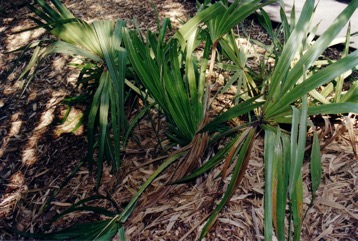
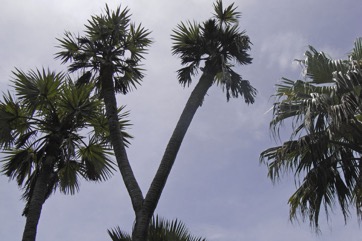
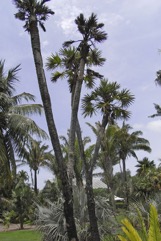
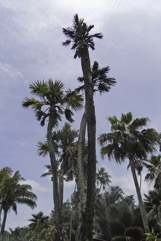
References
Abbiw, D.K., 1990, Useful Plants of Ghana. West African uses of wild and cultivated plants. Intermediate Technology Publications and the Royal Botanic Gardens, Kew. p 49
ABDELMUTI,
Addis, G., Asfaw, Z & Woldu, Z., 2013, Ethnobotany of Wild and Semi-wild Edible Plants of Konso Ethnic Community, South Ethiopia. Ethnobotany Research and Applications. 11:121-141
Ambasta S.P. (Ed.), 2000, The Useful Plants of India. CSIR India. p 281
Asfaw, Z. and Tadesse, M., 2001, Prospects for Sustainable Use and Development of Wild Food Plants in Ethiopia. Economic Botany, Vol. 55, No. 1, pp. 47-62
Atato, A., et al, 2010, Diversity of Edible Wild Fruit Tree Species of Togo. Global Science Books.
Ayantunde, A. A., et al, 2009, Uses of Local Plant Species by Agropastoralists in South-western Niger. Ethnobotany Research and Applications. Vol. 7: 53-66
Bahru, T., et al, 2013, Wild Edible Plants: Sustainable Use and Management by Indigenous Communities in and the Buffer Area of Awah National Park, Ethiopia. Ethiop. J. Sci., 36(2): 93-108
Ballal, M. E., et al, 2014, Ethno-botany of Natural Forests of Nuba Mountains, South Kordofan State, Sudan. Journal of Forest Poducts & Industries. 3(1):13-19
Balick, M.J. and Beck, H.T., (Ed.), 1990, Useful palms of the World. A Synoptic Bibliography. Colombia p 651 (As Hyphaene crinita)
Bekele-Tesemma A., Birnie, A., & Tengnas, B., 1993, Useful Trees and Shrubs for Ethiopia. Regional Soil Conservation Unit. Technical Handbook No 5. p 278
Bernholt, H. et al, 2009, Plant species richness and diversity in urban and peri-urban gardens of Niamey, Niger. Agroforestry Systems 77:159-179
BERRY-KOCH,
Balick, M.J. and Beck, H.T., (Ed.), 1990, Useful palms of the World. A Synoptic Bibliography. Colombia p 66, 122, 149, 434, 513, 628,
Bodkin, F., 1991, Encyclopedia Botanica. Cornstalk publishing, p 573
Brickell, C. (Ed.), 1999, The Royal Horticultural Society A-Z Encyclopedia of Garden Plants. Convent Garden Books. p 545
Burkill, H. M., 1985, The useful plants of west tropical Africa, Vol. 4. Kew.
Codjia, J. T. C., et al, 2003, Diversity and local valorisation of vegetal edible products in Benin. Cahiers Agricultures 12:1-12
CRÉAC'H,
Cundall, P., (ed.), 2004, Gardening Australia: flora: the gardener's bible. ABC Books. p 723
Dalziel, J. M., 1937, The Useful plants of west tropical Africa. Crown Agents for the Colonies London.
Etherington, K., & Imwold, D., (Eds), 2001, Botanica's Trees & Shrubs. The illustrated A-Z of over 8500 trees and shrubs. Random House, Australia. p 390
Facciola, S., 1998, Cornucopia 2: a Source Book of Edible Plants. Kampong Publications, p 29
FAO, 1988, Traditional Food Plants, FAO Food and Nutrition Paper 42. FAO Rome p 333
Flora of Pakistan. www.eFloras.org
Food Composition Tables for use in Africa FAO http://www.fao.org/infoods/directory No. 910 No. 911 (As Hyphaene dankaliensis)
Fruct. sem. pl. 2:13, t. 82, fig. 4. 1790 (As Hyphaene crinita)
Gibbons, M., 2003, A pocket guide to Palms. Chartwell Books. p 117
Gilbert, T., et al, 2017, Diversity and local transformation of indigenous edible fruits in sahelian domain of Cameroon. Journal of Animal & Plant Sciences Vol. 26 (2): 5289-5300
Hanawa, Y., 2013, Wild edible plants used by Guiziga people of far northregion of Cameroon. Int. J. Med. Arom. Plants. Vol 3 (2) : 136-143
Harris, F. M. A. and Mohammed, S., 2003, Relying on Nature: Wild Foods in Northern Nigeria. Ambio Vol. 32 No. 1. p 25-30
Haynes, J., & McLaughlin, J., 2000, Edible palms and Their Uses. University of Florida Fact sheet MCDE-00-50-1 p 6
Hedrick, U.P., 1919, (Ed.), Sturtevant's edible plants of the world. p 352
HENRY & GRINDLEY (1954),
Heywood, V.H., Brummitt, R.K., Culham, A., and Seberg, O., 2007, Flowering Plant Families of the World. Royal Botanical Gardens, Kew. p 348
Hist. nat. palm. 3:226, t. 131-133. 1838
Ibrahim, H. A., et al, 2012, Ethnobotanical Survey of the Wild Edible Food Plants Consumption among Local Communities in Kano State, North-Western, Nigeria, International Journal of Science and Technology. Vol. 2. No. 10 p 716
Janick, J. & Paul, R. E. (Eds.), 2008, The Encyclopedia of Fruit & Nuts. CABI p 130
Jardin, C., 1970, List of Foods Used In Africa, FAO Nutrition Information Document Series No 2.p 16, 34, 82. p 142 (As Hyphaene dankaliensis)
Jones, D.L., 1994, Palms throughout the World. Smithtonian Institution, Washington. p 54, 230
Jones, D.L., 2000, Palms of Australia 3rd edition. Reed/New Holland. p 165
Kiple, K.F. & Ornelas, K.C., (eds), 2000, The Cambridge World History of Food. CUP p 1769
Le Houerou, H. N., (Ed.), 1980, Browse in Africa. The current state of knowledge. International Livestock Centre for Africa, Ethiopia. p 163
Lulekal, E., et al, 2011, Wild edible plants in Ethiopia: a review on their potential to combat food insecurity. Afrika Focus - Vol. 24, No 2. pp 71-121
Martin, F.W. & Ruberte, R.M., 1979, Edible Leaves of the Tropics. Antillian College Press, Mayaguez, Puerto Rico. p 210
Martin, F. W., et al, 1987, Perennial Edible Fruits of the Tropics. USDA Handbook 642 p 47
Maydell, H. von, 1990 Trees and shrubs of the Sahel: their characteristics and uses. Margraf. p 303
Menninger, E.A., 1977, Edible Nuts of the World. Horticultural Books. Florida p 135
Peters, C. R., O'Brien, E. M., and Drummond, R.B., 1992, Edible Wild plants of Sub-saharan Africa. Kew. p 38
Purseglove, J.W., 1972, Tropical Crops. Monocotyledons. Longmans p 425
Riffle, R.L. & Craft, P., 2003, An Encyclopedia of Cultivated Palms. Timber Press. p 354
Royal Botanic Gardens, Kew (1999). Survey of Economic Plants for Arid and Semi-Arid Lands (SEPASAL) database. Published on the Internet; http://www.rbgkew.org.uk/ceb/sepasal/internet [Accessed 5th May 2011]
(Also as Hyphaene crinita)
Ruiters-Welcome, A. K., 2019, Food plants of southern Africa. Ph.D. thesis. Univ. of Johannesburg p 29
Salih, N. K. M., & Ali, A. H., 2014, Wild food trees in Eastern Nuba Mountain, Sudan: Use, diversity, and threatening factors. Journal of Agriculture and Rural Development in the Tropics and Subtropics Vol. 115 No. 1 pp 1-7
Schuler, S., (Ed.), 1977, Simon & Schuster's Guide to Trees. Simon & Schuster. No. 57
Segnon, A. C. & Achigan-Dako, E. G., 2014, Comparative analysis of diversity and utilization of edible plants in arid and semi-arid areas in Benin. Journal of Ethnobiology and Ethnomedicine 2014, 10:80
Sukarya, D. G., (Ed.) 2013, 3,500 Plant Species of the Botanic Gardens of Indonesia. LIPI p 783
Vanderjagt, F. J., et al, 2000, The trypsin inhibitor content of 61 wild edible plant foods of Niger. Plant Foods for Human Nutrition 55: 335–346, 2000.
Vickery, M.L. and Vickery, B., 1979, Plant Products of Tropical Africa, Macmillan. p 99
Wickens, G.E., 1995, Edible Nuts. FAO Non-wood forest products. FAO, Rome. p166
World Checklist of Useful Plant Species 2020. Royal Botanic Gardens, Kew
www.worldagroforestrycentre.org/treedb/